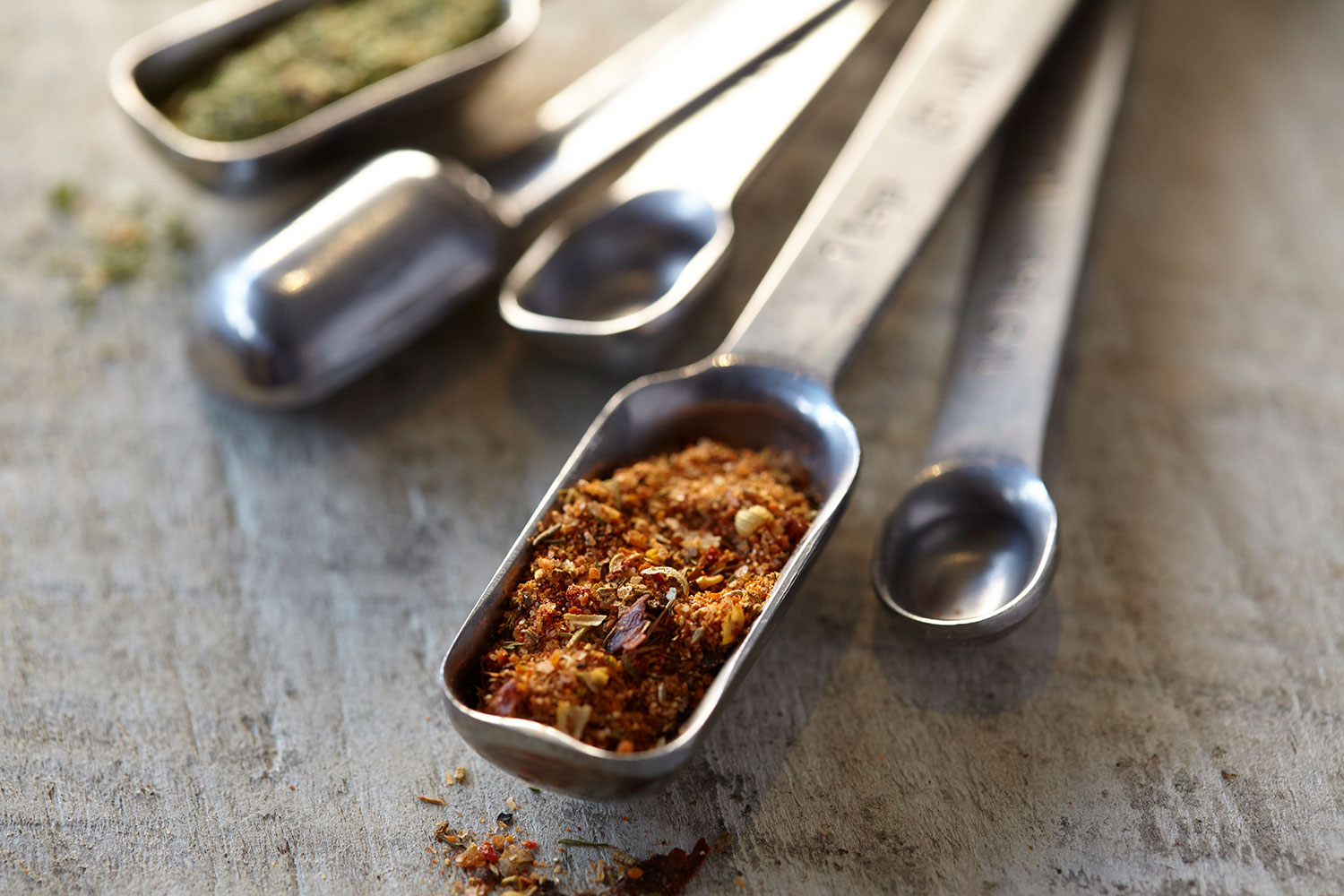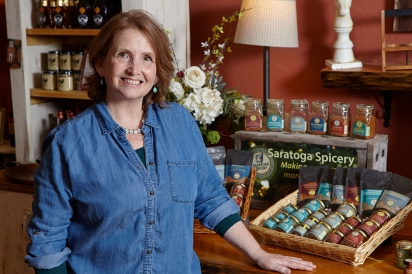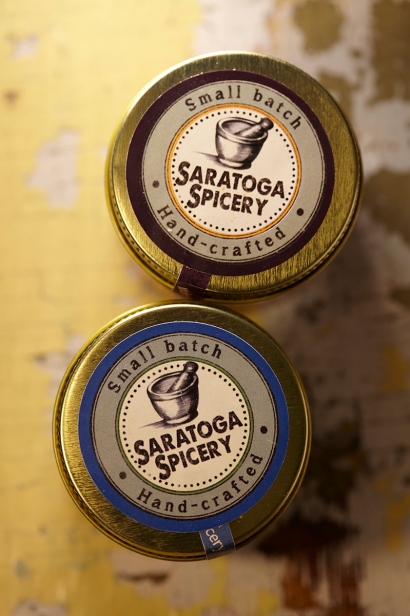Local Spice for a Taste of the World
Secluded in every person’s home is a secret, magical object capable of sending them hurtling through space and time, on missions to foreign lands, to childhood decades long past, forgotten cultures: The spice cabinet.
If the palate is our gateway to exploration, excitement and memory, then spices are the passport that waves us through the door.
Because spices are readily available in ever-increasing varieties and relatively cheap, we take their wizardry for granted. A mill brimming with South Indian native piper nigrum—aka black pepper—the world’s most widely traded spice, can be found on the dinner tables of rich and poor, all over the world. A few grinds is hardly even worth a penny. Five centuries ago though, pepper and other marginally more exotic spices like cloves were so valuable, entire empires were built on the pure pleasure just a pinch could bring.
America, after all, was happened upon by Christopher Columbus while he was out on a jaunt to find a spice route shortcut.
Spices may be cheap, but that doesn’t make them any less precious. Like oxygen for our bodies, spice breathes life into everything in our kitchen.
“What dish reminds you most of your childhood?” Susi Kerr, the founder of the Saratoga Spicery, asks me over a cup of coffee.
Without a doubt, spaghetti Bolognese: a dish derided gleefully by “real” Italians and embraced with delighted, clueless American abandon by lovers of carbs, meat and cheese, especially in the 1980s. Or in the unsophisticated parlance of my five-year-old self, “Daddy’s Sgetti,” made by simmering a humble ragù of ground beef, pork, veal, hand-crushed tomatoes, wine, onions, crushed garlic and a dried Italian seasoning blend for hours. Fettucine, a few grinds of black pepper, mounds of freshly grated Parm.
Bliss.
“Do you still make it today?” she asks. Of course. And yes, like my Dad, I still crush up obscene amounts of fresh garlic and sprinkle in that dried Italian seasoning blend. I tried sneaking in fresh basil, oregano, parsley and it was so much better, but really … so much worse, because it didn’t precisely evoke the dish my Dad made, and that deep, comforting, gustatory childhood “mmmm” was silenced.
“Spices are often like a time capsule,” Susi says. “They can bring us back to our warmest memories of childhood, or to an amazing trip you took.”
Susi should know, having spent the last few years deeply immersed in the minutiae of herbs. She has a background in museum education and has spent many years straddling the line between creation and education, yet she yearned to build a tangible business that utilized all of her skills and capture their essentially ethereal, unsubstantial character while still actually, you know, producing something.
“I was working part-time at Saratoga Olive Oil and I had an a-ha moment because customers kept coming in asking for something to sprinkle on their olive oil for bread dipping,” she recalls.
Speaking to the owners, Barbara and Clint Braidwood, who had been fielding the same question for years, she realized there was a gaping niche to fill.
“They didn’t want to use just any spice blend,” Susi explains. “It would have to be as fresh, local, sustainable and responsibly grown as possible.”
That’s a challenge, even with year-round biodynamic hoop-houses cropping up around the district.
But Susi embraces the challenge, both the global nature of her project and her ability to support as many small-scale responsible farmers as possible and vendors close to home.
“Even with technology, the realities of climate being what they are, spices like cinnamon will never be a New York product,” Susi admits. “But I try to bring the ‘think local, think sustainable’ concept to all of my business transactions.” She goes direct to the source as often as possible, seeking out product from family farmers in India, Europe, Africa and the Middle East, and sourcing from New York producers whenever possible.
Like many smaller-scale artisanal food companies, she utilizes a shared kitchen space at Cake by Alissa in Schuylerville to make her current line of blends (see sidebar for a menu) and work on a new line of spices and blends, which will debut this summer.
“We are going to do single herbs, including many organics,” Susi says. “My creative partner and I are also perfecting a few new blends, like an Indian curry, a Moroccan ras el hanout, and a French herbes de Provence that is more traditional than most of the ones you find in the United States, which have lavender.”
Susi is also perfecting two sweet blends, which will feature some New York producers. She’s very happy with a local maple sugar that she uses in one blend, but is still searching for the right local honey powder for another. “My dream was to do a local evaporated New York honey blend with cinnamon, but after researching and experimenting, I found that evaporated honey is too light. For it to work, I’d have to add a filler to weigh the honey down!”
She grimaces visibly. “I would never add filler. Everything is freshly ground and blended and we sell them in small batches so people can use them in three to six months, max.”
In addition to creating blends at the Spicery, Susi built her website, designed the label (majoring in printmaking in college finally came in handy, she says wryly) and makes the buying and strategic business decisions. Although the final decision-making falls to her, she says she relies on her family as a sounding board.
“Working on a very small global business has made me appreciate how simultaneously large and how small our world is,” Susi reflects. “We used to get our Aleppo pepper from family farmers in Syria, but because of the war, it’s getting harder and harder for them to continue their work. It’s heartbreaking to see.”
While Susi doesn’t have the power to stretch out her hand to save those family farmers, she does have the power to reach out to local businesses here.
“We get all of our jars and bottles from Burch Bottle in Waterford,” she says. “I discovered these guys right here, with the absolutely perfect bottle for us. I’m so happy I can use them and not have to rely on someone to ship them to me.”
Susi’s artistic instinct can be seen in the packaging, and her passion for education can be seen in her side projects that feature, but hardly star, the Saratoga Spicery.
“I teach an after-school program for elementary school children through BOCES,” she explains. “The main ‘challenge’ of the Potato Chip Challenge is for the kids to create a new flavor of potato chip. We work on recipes and experiments, often using the spice blends I have and also having them build their own. Then they do taste tests and they bring their recipes home.” Working with spices and blends hands-on, and then having access to them later at home, has transformed some children’s approaches to food,” she says.
“I have parents come up to me all the time and tell me that they add their little spice blends to everything on their plate and suddenly they’re trying things they never would have touched before,” Susi adds.
The high-quality, fresh spice blends from Saratoga Spicery are slightly more expensive than their mass-market counterparts, but they are a world away in terms of the quality of the product and the ethos behind it.
Hungering for a local taste of the world? Saratoga Spicery blends are available at Saratoga Olive Oil Co. and Moby Rick’s Seafood in Saratoga.
Saratoga Spicery Cabinet
Greek Seasoning Blend: oregano, parsley, rosemary, dehydrated garlic powder, fragrant basil, delicate thyme, fresh ground nutmeg, bold Tellicherry black pepper and Himalayan pink crystal salt.
Kickin’ Cajun Blend: mild spiciness with just a bit of temperate heat that delights the palate, balanced with the aromatics of fragrant coriander, onion and garlic and the tastes of hearty oregano, sweet paprika and floral thyme.
Lemon-Pepper Seasoning: minced lemon peel, cracked extra-bold Tellicherry black pepper, minced dehydrated onion, pristine Himalayan pink crystal sea salt (gourmet food grade), dehydrated garlic and 100% pure citric acid (lemon salt).
Midnight Red Seasoning: pungent Hungarian Paprika, woodsy sweet smoked Spanish paprika, crushed robust Aleppo pepper, nutty cumin, cracked Tellicherry bold black pepper, chipotle “meco” (smoked jalapeño) chile powder, dehydrated garlic powder, minced dehydrated onion, red pepper flakes, sweet Greek oregano and ancient Himalayan pink crystal sea salt.
Montreal Steak Seasoning: Himalayan pink sea salt, Hungarian paprika, Tellicherry black pepper, garlic, onion, roasted red bell pepper, black mustard seed, coriander, hot pepper flakes, rosemary, thyme and dill weed.








